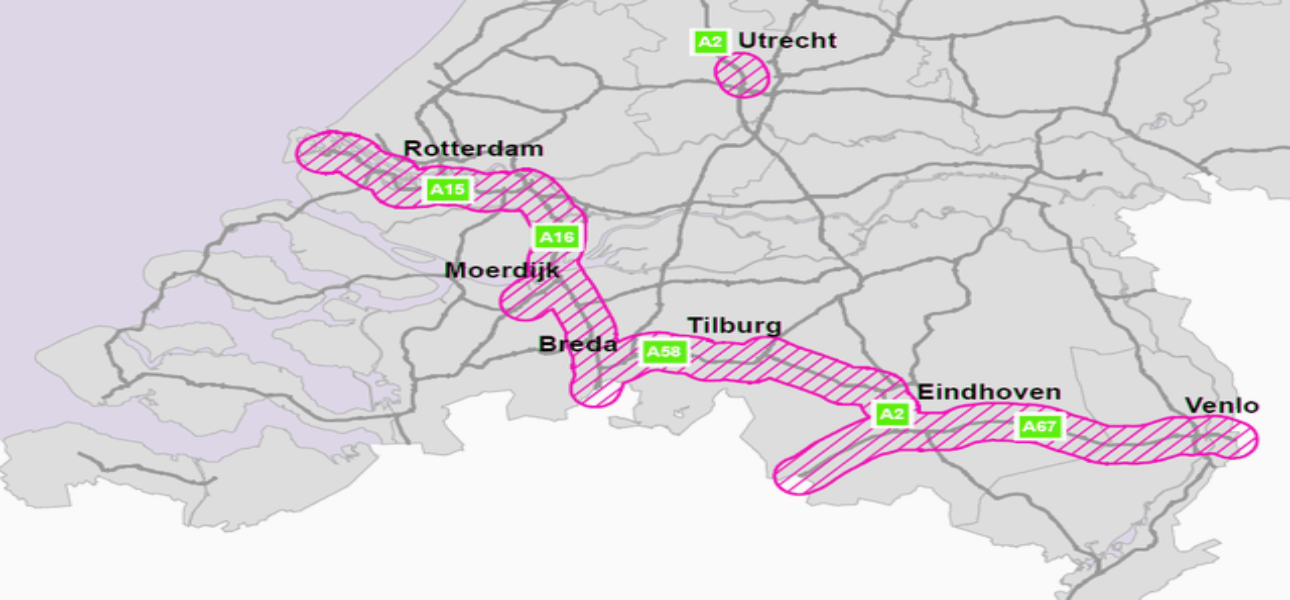When it comes to logistics infrastructure, few countries in Europe can match the Netherlands’ efficiency, connectivity, and planning foresight. At the heart of this success are two crucial arteries: the A15 and A67 corridors. Together, they form the backbone of Dutch logistics, connecting ports, warehouses, and European distribution networks.
The A15 corridor links Rotterdam, Europe’s largest seaport, with the German border, serving as a direct highway for goods flowing between the North Sea and Central Europe. The upcoming ViA15 project, a €1.4 billion public-private initiative will extend and connect the A15 to the A12, strengthening east-west trade efficiency and alleviating congestion in the Arnhem-Nijmegen region.
Meanwhile, the A67 corridor stretches from Eindhoven to Venlo and continues into Germany. This route is part of the vital Eindhoven-Venlo–Duisburg triangle, a powerful logistics region that supports some of Europe’s largest e-commerce and industrial players. Venlo alone has consistently been ranked as one of Europe’s top logistics hubs.
(source: Cushman & Wakefield’s European Logistics & Industrial Market Update 2024)
Together, these two corridors are not merely highways, they represent economic arteries, fueling trade, employment, and real estate investment across the Netherlands and beyond.
How Are Infrastructure Investments Shaping These Corridors?
The Netherlands’ logistics strategy is tightly linked with its infrastructure development. Recent and ongoing projects are amplifying the role of A15 and A67 in the country’s logistics map.
Key infrastructure developments
- ViA15 Extension (A12–A15 link):
Expected to open by 2030, this extension closes a missing link between the Port of Rotterdam and Germany, reducing travel time by up to 30 minutes for freight trucks
- A67 Upgrades:Continuous investments by Rijkswaterstaatfocus on smart traffic systems and widening sections prone to congestion, especially between Eindhoven and Venlo
- Rail and Inland Waterway Integration:
Intermodal hubs such as Waalhaven, Valburg, and Venlo Rail Terminal are aligning with these road networks to streamline multimodal freight
- Sustainability enhancements:
Both corridors are part of the Netherlands’Green Deal for Logistics, encouraging electric vehicle infrastructure and low-emission freight operations
These efforts ensure that the A15 and A67 corridors will remain future-ready, supporting the country’s ambition to stay Europe’s logistics gateway. Explore RRE Projects
Why Are Occupiers and Investors Turning Toward These Corridors?
The surge in demand for logistics real estate along these routes is driven by three converging forces: e-commerce expansion, supply chain resilience, and sustainability commitments.
For occupiers,the corridors provide:
- Access to major markets:Rotterdam, Venlo, and Eindhoven offer rapid reach into Germany, Belgium, and France
- Operational efficiency:Companies can reduce fuel costs and delivery times through improved traffic flow and multimodal options
- ESG advantage:Many new developments along these routes are BREEAM-certified, featuring solar rooftops, EV bays, and energy-neutral operations
For investors and developers, these corridors promise:
- High demand stability:Core locations with limited supply and consistent tenant interest
- Attractive yield profiles: Despite yield compression, logistics assets here still outperform other asset classes on risk-adjusted returns
- Strong governmental support: Public funding and streamlined zoning for logistics make development faster and less speculative
With land scarcity tightening around traditional hubs like Amsterdam and Utrecht, the A15–A67 axis has emerged as the next frontier for logistics real estate investment.
Real-World Examples of Corridor-Driven Growth
1. The A15 Corridor: Powering Rotterdam’s Hinterland
- VGP Park Nijmegen and CTPark Rotterdam are prime examples of developments capitalising on A15 access
- The area between Tiel, Nijmegen, and Arnhem is transforming into a high-density logistics belt for automotive, retail, and FMCG occupiers
- The Betuwe Route, a dedicated freight rail line parallel to the A15, strengthens Rotterdam’s multimodal export network
2. The A67 Corridor: Connecting Eindhoven and Venlo to Europe
- Venlo continues to hold its position as Europe’s “Logistics Hotspot Number One”, thanks to its proximity to Germany and seamless access via the A67
- Major players such as DHL, Dachser, and DSV operate distribution centres here
- The Greenport Venlo region integrates high-tech warehousing, circular economy initiatives, and sustainable design principles, attracting institutional investors from across Europe.
See how our Venlo Project is shaping Dutch Logistics
3. ViA15 Link: A Game-Changer for the East-West Flow
- The ViA15 motorway extension, led by HOCHTIEF and BESIX, will link the A12 and A15, removing the current bottleneck near Zevenaar
- Once complete, it will shorten freight transit times, reduce CO₂ emissions through smoother traffic flow, and increase land values along the route
- It’s expected to open new opportunities for logistics parks, brownfield redevelopment, and sale-leaseback transactions
What Trends Are Emerging Around These Corridors?
Several macro and micro trends are shaping logistics real estate strategies around the A15 and A67:
- On-shoring and near-shoring:European manufacturers are bringing production closer to home, fuelling warehouse demand along east-west routes
- Speculative vs. built-to-suit:Developers are balancing risk with demand, speculative builds are increasing but often pre-let before completion
- Sustainability compliance:The EU’s Corporate Sustainability Reporting Directive (CSRD) is pushing occupiers toward greener logistics assets
- Digitalisation:Advanced automation systems and IoT-driven logistics hubs are being deployed in new facilities along these corridors
- Land scarcity and conversion:Older industrial sites along the A15 and A67 are being redeveloped into Grade-A logistics parks
According to CBRE’s Netherlands Industrial Outlook 2025, over 40% of new logistics developments in the next three years are projected to concentrate around these two corridors, highlighting their central role in national planning.
Why These Corridors Represent Long-Term Investment Value
The strategic advantage of the A15 and A67 corridors extends beyond operational benefits. They represent long-term economic resilience.
For the Dutch economy:
- They sustain trade competitiveness by keeping logistics costs low
- They decentralise development, supporting regional growth outside the Randstad
For investors:
- Properties along these routes benefit from low vacancy rates and steady rental growth
- Institutional investors see them as reliable core-plus opportunities with yield compression balanced by strong fundamentals
In essence, the A15 and A67 are not only the physical backbone of Dutch logistics but also the investment compassguiding capital toward sustainable, high-value assets.
How RENEW Real Estate (RRE) Enables Corridor-Focused Investment
Op RENEW Vastgoed (RRE), we recognise the A15 and A67 corridors as the next great frontier of European logistics growth. Our expertise spans the entire lifecycle of logistics real estate from sourcing and structuring deals to development and asset management. We offer:
- Strategic Acquisitions: Identifying off-market and under-valued logistics assets along key corridors with strong tenant profiles
- Sale & Leaseback Solutions: Helping occupiers unlock capital tied in real estate while retaining operational continuity, especially relevant for transport, manufacturing, and retail companies
- Development Partnerships: Engaging in build-to-suit, forward funding, and brownfield conversion projects that align with ESG and automation-ready standards
With deep insight into local market drivers and pan-European investor relationships, RRE bridges capital with opportunity, ensuring value creation through disciplined, data-driven strategies.


